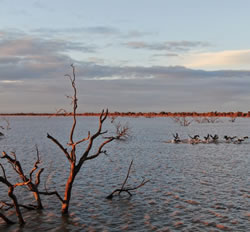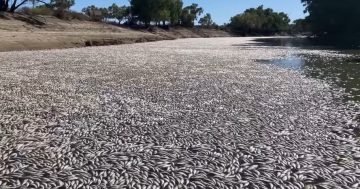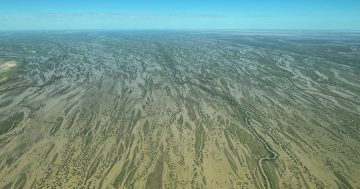 The Department of Planning, Industry and Environment’s (DPIE) Water branch is working with Water NSW to manage the risk of fish deaths in the State’s west, as floodwaters low in oxygen levels move downstream from the Barwon-Darling River.
The Department of Planning, Industry and Environment’s (DPIE) Water branch is working with Water NSW to manage the risk of fish deaths in the State’s west, as floodwaters low in oxygen levels move downstream from the Barwon-Darling River.
Director of Water Planning Implementation at DPIE, Allan Raine said hypoxic, or low oxygen, blackwater was a natural feature of Australian lowland river systems and occurred when high volumes of organic material, such as sticks, leaves, bark and grass were broken down in the floodwater or washed off the floodplain into the river.
“Too much organic material can significantly reduce oxygen levels, which can result in fish deaths,” Mr Raine said.
“With large volumes of water currently moving across the floodplain, there is often very little that can be done to prevent hypoxic blackwater developing,” he said.
“This is typical of the Barwon-Darling River, which has one of the highest flow variabilities in Australia.”
Mr Raine said floodwaters from heavy rain in the Northern Murray-Darling Basin during November recently peaked at Louth, NSW and were making their way down the Darling River.
The Director said the peak flow was expected to reach Menindee Lakes in the third week of February.
“The scale of this hypoxic blackwater event is substantial and there is a very high risk of fish deaths unless cooler temperatures continue,” he said.
“The two major risks over the coming weeks are the floodwaters that are low in dissolved oxygen levels moving into the Menindee Lakes and the potential for floodwaters on the lower Darling floodplain to flow into the lower Darling River.”
Executive Manager of Systems Operations at WaterNSW, Adrian Langdon said releases from Menindee Lakes into the lower Darling would shortly be reduced.
“This will allow low dissolved oxygen water, returning from the lower Darling floodplain, to start mixing so it is diluted before the blackwater front flowing downstream from the Barwon-Darling is released from Lake Wetherell,” Mr Langdon said.
“Releases from the other lakes will continue into the lower Darling via Weir 32 to help dilute the water being released from Lake Wetherell and to provide smaller, higher dissolved oxygen, refuge areas,” he said.
Mr Langdon said the smaller lakes would act as a refuge for fish, allowing them to move into the areas to escape low dissolved oxygen water in Lake Wetherell.




